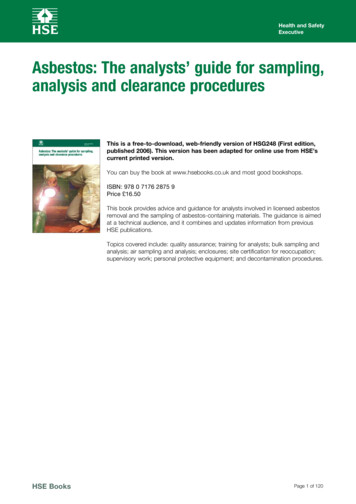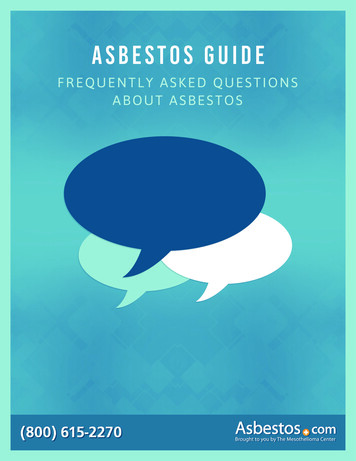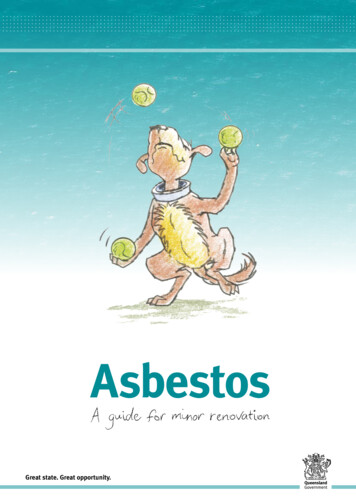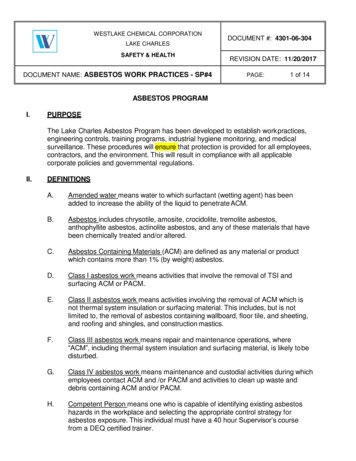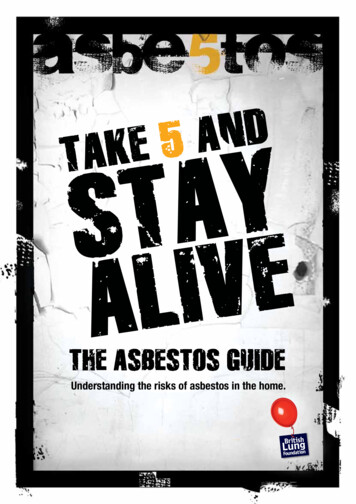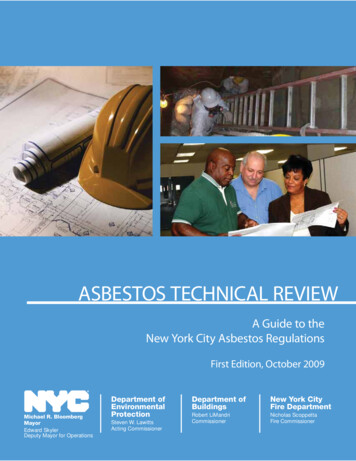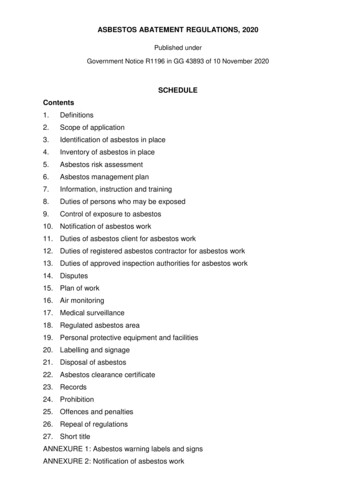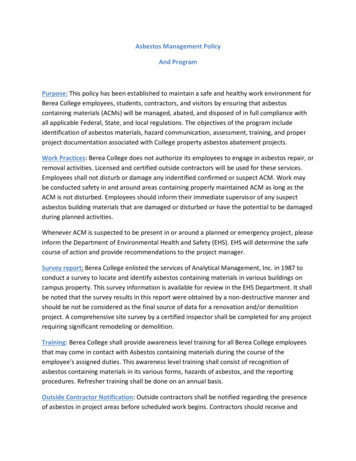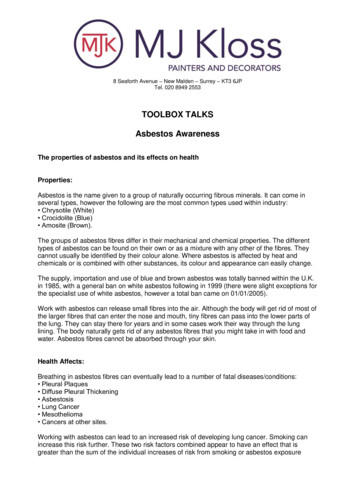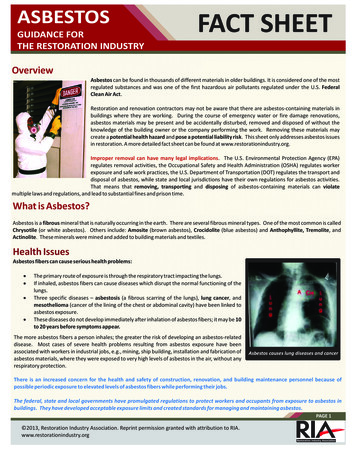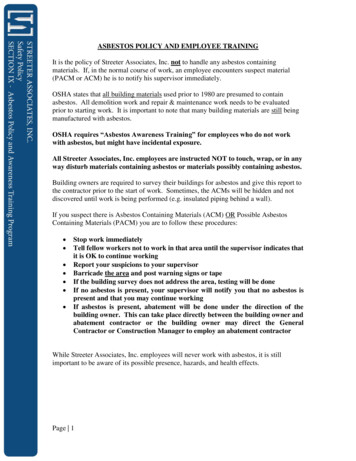
Transcription
ASBESTOS POLICY AND EMPLOYEE TRAININGIt is the policy of Streeter Associates, Inc. not to handle any asbestos containingmaterials. If, in the normal course of work, an employee encounters suspect material(PACM or ACM) he is to notify his supervisor immediately.OSHA states that all building materials used prior to 1980 are presumed to containasbestos. All demolition work and repair & maintenance work needs to be evaluatedprior to starting work. It is important to note that many building materials are still beingmanufactured with asbestos.OSHA requires “Asbestos Awareness Training” for employees who do not workwith asbestos, but might have incidental exposure.All Streeter Associates, Inc. employees are instructed NOT to touch, wrap, or in anyway disturb materials containing asbestos or materials possibly containing asbestos.Building owners are required to survey their buildings for asbestos and give this report tothe contractor prior to the start of work. Sometimes, the ACMs will be hidden and notdiscovered until work is being performed (e.g. insulated piping behind a wall).If you suspect there is Asbestos Containing Materials (ACM) OR Possible AsbestosContaining Materials (PACM) you are to follow these procedures: Stop work immediatelyTell fellow workers not to work in that area until the supervisor indicates thatit is OK to continue workingReport your suspicions to your supervisorBarricade the area and post warning signs or tapeIf the building survey does not address the area, testing will be doneIf no asbestos is present, your supervisor will notify you that no asbestos ispresent and that you may continue workingIf asbestos is present, abatement will be done under the direction of thebuilding owner. This can take place directly between the building owner andabatement contractor or the building owner may direct the GeneralContractor or Construction Manager to employ an abatement contractorWhile Streeter Associates, Inc. employees will never work with asbestos, it is stillimportant to be aware of its possible presence, hazards, and health effects.Page 1
Asbestos AwarenessWhat is asbestos?Asbestos is a naturally occurring mineral that takes the form of hollow, microscopic fiberswhich are nearly indestructible. It can be densely packed into a tough, flexible and veryuseful material, which has been used for hundreds of years as an insulation, fireproofing,and building material.There are three major types of asbestos used in building and industry: Crysotile, or white asbestos – use as insulation, fireproofing and soundproofing.Amosite, or brown asbestos – used in high friction applications like brake shoes &clutches.Crocilodite, or blue asbestos – not as common as the other two, but the most toxicform.About 95% of all asbestos used in the U.S. has been chrysotile, the least toxic form ofasbestos.Where is asbestos found?Asbestos is often a component in the following materials: FireproofingThermal insulationBoilersBuilding ventilation systemsCeiling tilesVinyl floor tilesDry wall, dry wall tape and plasterTexturized paintsRoofing shingles, felt, tar, flashingDecorative building materialsSheathing on electronics and power cablesAutomotive brake pads and clutches
Can asbestos be identified visually?There is no way to visually identify asbestos. Many materials that contain asbestos lookjust the same as materials that don’t. The only way to confirm that a material is asbestosis to take samples and analyze the material in a laboratory. Therefore, it is best to treatanything that looks like it may contain asbestos as if it does until it is analyzed and provento not contain any asbestos.When is asbestos a potential health hazard?Asbestos that is “friable” may be crumbled, pulverized or reduced to powder in your handwhen dry. Friable asbestos has the potential to release asbestos fibers that can be comeairborne, and potentially create a health hazard.Asbestos that is bonded, coated, painted, covered, or otherwise protected so that is doesn’trelease airborne fibers does not present a health hazard.What are some health effects that could result from exposure to airborneasbestos fibers? Asbestosis – a progressive, non-cancerous and irreversible scarring of the lungsthat can produce shortness of breath. Typical latency period is over 20 years.Pleural disease – plaque deposits or a thickening of the thin tissue that separatesthe lungs from the other organs in the body.Lung cancer – cancerous tumors that have a latency period of 20 to 30, usuallyfatal.Mesothelioma – a cancer in the lining of the chest cavity or abdomen, very rarebut always fatal.It is important to note that most asbestos related diseases have occurred in workerswho historically have had high exposures to asbestos. These exposures occurred inoccupations where asbestos was mined, milled, used in primary manufacturing, andin insulation trades, such as shipbuilding. Before asbestos was known to be a serioushealth hazard, exposure levels to airborne asbestos in these industries may have reachedover 100 fibers/cc. This is 1000 times higher than the current Occupational Health andSafety Administration (OSHA) Permissible Exposure Limit (PEL) of 0.1 fibers/cc.Workers whose only exposure to asbestos was in changing auto brake shoes containingasbestos have shown no increase incidence of any asbestos related disease.Research has shown that smoking significantly increases the risk of lung cancer inindividuals who are exposed to unsafe levels of asbestos.
What can you do to limit your exposure to asbestos?Most buildings, especially older ones, contain some amount of asbestos. But remember,asbestos is only a potential hazard if it is damaged and friable, releasing fibers intothe air we breathe.If you come across something that appears to be friable asbestos, such as damagedinsulation on a pipe, assume that it is asbestos, and notify your supervisor. Do notdamage or disturb the area. A sample of the material will be taken and analyzed. If it isdetermined to be asbestos, it will either be removed or repaired so that it is protected andno longer releasing fibers.If your job involves stripping or buffing floors that could be vinyl asbestos tile, this shouldbe done infrequently, using a wet method. A soft, non-abrasive pad should be used, andthe machine should be run at low speed (below 300 rpm). Do not burnish or dry-buffflooring unless it has sufficient finish so that the pad can’t contact the bare floor.
Asbestos Containing MaterialsNote: The following list does not include every product/material that may contain asbestos. It isintended as a general guide to show which types of materials may contain asbestos.Sample List of Suspect Asbestos – Containing MaterialsCement PipesElevator Brake ShoesCement WallboardHVAC Duct InsulationCement SidingBoiler InsulationAsphalt Floor TileBreaching InsulationVinyl Floor TileDuctwork Flexible Fabric ConnectionsVinyl Sheet FlooringCooling TowersFlooring BackingPipe Insulation (corrugated air-cell, block,etc.)Construction Mastics (floor tile, carpet,ceiling tile, etc.)Heating and Electrical DuctsAcoustical PlasterElectrical Panel PartitionsDecorative PlasterElectrical ClothTextured Paints/CoatingsElectric Wiring InsulationCeiling Tiles and Lay-in PanelsChalkboardsSpray-Applied InsulationRoofing ShinglesBlown-in InsulationRoofing FeltFireproofing MaterialsBase FlashingTaping Compounds (thermal)Thermal Paper ProductsPacking Materials (for wall/floorpenetrations)Fire DoorsHigh Temperature GasketsCaulking/PuttiesLaboratory Hoods/Table TopsAdhesivesLaboratory GlovesWallboardFire BlanketsJoint CompoundFire CurtainsVinyl Wall CoveringsElevator Equipment PanelsSpackling Compounds
asbestos. All demolition work and repair & maintenance work needs to be evaluated prior to starting work. It is important to note that many building materials are still being manufactured with asbestos. OSHA requires "Asbestos Awareness Training" for employees who do not work with asbestos, but might have incidental exposure.
